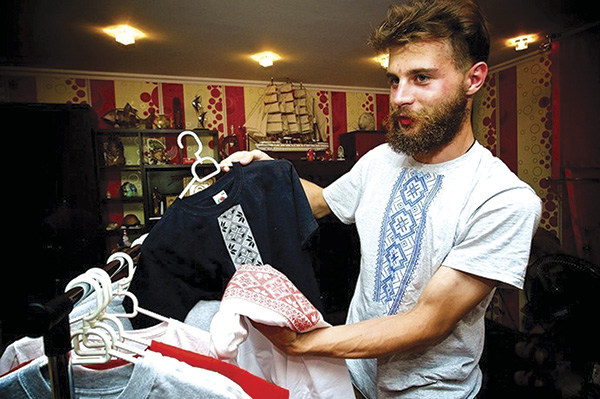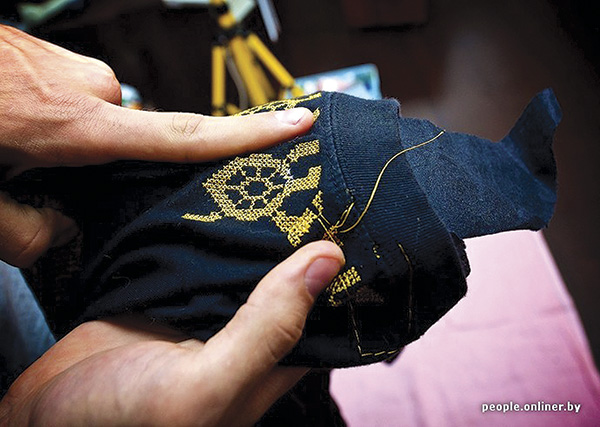Anton Talashko, 23, is bucking modern trends, caring little for technology or the latest football results in the Champions’ League. After graduating from a Gomel university, he decided to return to his native Malorita, explaining, “Money matters little to me. It’s much more important to do what brings pleasure.”

In Malorita, he lectures in electrical-technical engineering at the Agricultural Lyceum, spending his spare time in museums or at his embroidery machine. He is fascinated by traditional Belarusian motifs, which he prints on T-shirts, aprons and fleeces. Anton is convinced that these motifs have relevance today, and will grow in popularity. Looking at his work, it’s hard not to agree.
“Around eight months ago, I saw popular ‘vyshimaika’ (embroidered T-shirts). I loved the idea and decided to create something of my own,” the young man comments. “T-shirt printing is actually quite simple, so it doesn’t interest me, but placing Belarusian ornamentation via embroidery is another matter. My mother taught me the skill and I set myself the goal of not only making beautiful clothes but promoting the rich diversity of Belarusian costume.”
Anton began focusing on traditional ‘kashulya’ but then put the idea aside, being eager to create something both modern and ‘ancient’. It’s turned out that Belarusian motifs look great on daily clothes.
To develop his ideas, Anton went to the Malorita District Centre of Folk Crafts. “I’d lived all my life in Malorita but had only visited the Centre a couple of times,” he says. “I could hardly have imagined that it would be so interesting. Malorita clothing is unique, as is well documented in books on the history of Belarusian costume. Our district presented around 80 costumes at Dozhynki; interestingly, only two were for men.”
Anton took photos of motifs and patterns and found them online, digitizing them, which can be rather time-consuming. He explains, “In working with a pattern, I’m always struck by our masters’ talent and patience. It’s hard to imagine how much time they needed to create a single pattern. Probably, they worked through the winter, when there was little field work.”

It takes around three hours for Anton to embroider one T-shirt and, so far, he has digitized almost 130 Belarusian motifs and patterns have. He admits that each garment is unique, being made by hand.
Clothes produced by the Rodny Kut (Native Land) workshop enjoy demand across all ages, being ordered online and bought at shows and concerts, by people from Belarus and abroad.
Anton is pleased and inspired by the fashion for Belarusian clothes. “It’s especially wonderful when someone makes a conscious choice to wear clothes with Belarusian ornamentation, rather than following some modern trend. People understand that patterns and motifs are part of our history, uniting Belarusians. Pleasingly, some people’s interests reach beyond the latest mobile handset,” he adds.
Not long ago, the young man embroidered a wedding dress with white threads, having been inspired by designs at the Malorita Centre of Folk Crafts. The dress was beautiful and unique and far less expensive than those from the shops.
Anton can’t help but view his hobby as a social project rather than a business, as it’s much easier to make money from printed T-shirts. His goals differ, as he points out that the legacy of skills often dies with the master, losing traditions. “I’d love to preserve them, to demonstrate that we boast such rich culture. Sadly, many have no idea of this.”
By Pavel Losich
Profile
Anton Talashko, 23, graduated from the Gomel State Technical University named after P. O. Sukhoy. He lectures in electrical-technical engineering at the Malorita Agricultural Lyceum. This year, Anton registered as a craftsman, setting up the Rodny Kut workshop. He has won a UNDP grant to realize his social project of preserving and promoting Belarusian ornamentation and the production of unique clothes for groups such as sports clubs and children’s teams.
Expert’s point of view
Valentina Strunets, Director of the Malorita District Centre of Folk Crafts:
I greatly appreciate and respect Anton Talashko’s business. In recent times, there’s been lively interest in Belarusian motifs and patterns. Some time ago, traditional Belarusian clothes were viewed as old-fashioned — as if from granny’s trunk. Anton’s work shows that ‘authentic’ can be given a modern twist. It’s a delight to see clothes with traditional Belarusian patterns enjoying increasing popularity with the younger generation.
Patterns for the sash
Mogilev Region weavers are working over Belarus’ longest sash

“Our master weavers plan to decorate the sash with new patterns and decoration and to try new weaving techniques, discovered during ethnographic exhibitions in their regions. This will not merely be work on the sash but also master classes for those wishing to study this ancient craft, traditional for Mogilev Region,” noted the Chair of the Mogilev Union of Folk Masters, Natalia Dominikova.
Last year, during the regional weaving seminar, the craftswomen laid the foundations for the rarity. At present, the sash is 35m long and 15cm wide. It will exceed 50m by the Kupalie holiday which is traditionally held in the agro-town of Alexandria of Shklov District in early July. To assist the project, master weavers from various corners of the region will come to Mogilev each month and continue to work on the sash.
The presentation of this unique item will be held on the Kupalie holiday (as last year). It’s expected that guests will be able to admire the sash as well as make a contribution to its weaving. Folk craftswomen will also help visitors master the secrets of this ancient craft.











